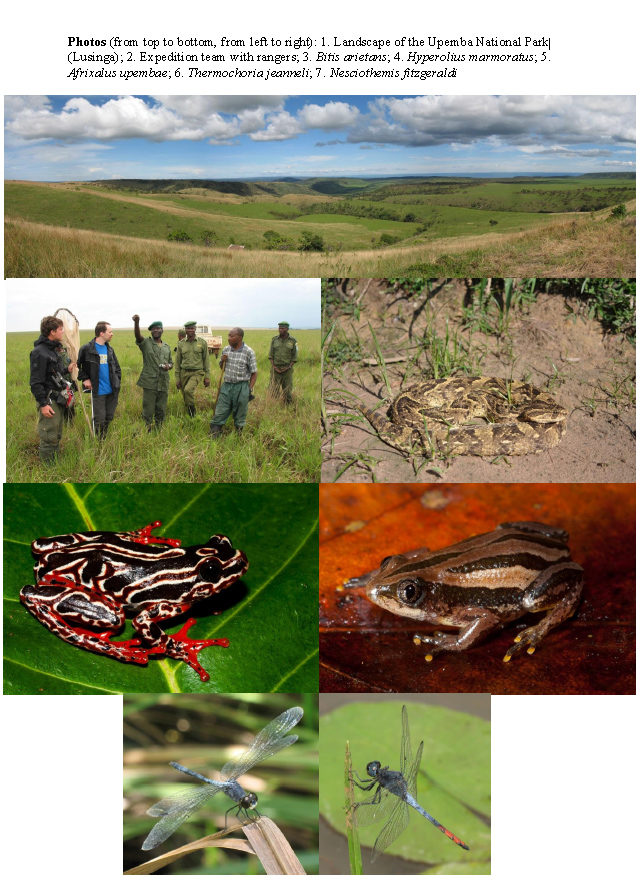 NAGY Zoltán T. (RBINS)
NAGY Zoltán T. (RBINS)
Assessing the diversity of the Central African herpetofauna – improving collections and herpetological knowledge.
Scientific report :
Expedition to the National Parks Upemba and Kundelungu, DRC
A one-month expedition in the Democratic Republic of the Congo was carried out in November 2011 as the first part of the capacity building project. Activities were supported by the Belgian National Focal Point to the Global Taxonomy Initiative as well as by the King Leopold III Fund for Nature Exploration and Conservation. The King Leopold III Fund contributed with additional 2000 EUR to the project.
Participants of the expedition with information on their qualification and involvement :
- Zoltán T. Nagy : Brussels, Belgium; specialized in herpetology; grant holder, Male, PhD, researcher, 1 person-month
- Zacharie Chifundera Kusamba : Lwiro and Kinshasa, DR Congo; specialized in herpetology, Male, MSc, PhD student, 1 person-month
- Jos Kielgast : Copenhagen, Denmark; specialized in herpetology, Male, MSc, 1 person-month
- Klaas-Douwe Dijkstra : Leiden, The Netherlands; specialized in odonatology, Male, PhD, 1 person-month
Initial plans were modified in order to avoid difficulties and potential troubles using Congolese domestic airlines, this alteration was accepted by both funding bodies. We have visited and surveyed three main sites in the southeastern part of the country in the Katanga province. These included the Upemba National Park around our base camp in Lusinga (coordinates: lat. -8.929053° lon. 27.201236°; in total 10 field days spent), the Kundelungu National Park in the proximity of our base camp in Katwe (coordinates: lat.-10.564742°, lon. 27.858430°; 6 field days) as well as the ‘Zone Annexe’ of the Kundelungu National Park around our base camp in Kiubo in the Lufira valley (coordinates: lat.-9.518166°, lon 27.035620°; 5 field days). Our work was logistically supported by the Frankfurt Zoological Society with sites in Lubumbashi and in Lusinga, and the Biodiversité au Katanga (BAK) asbl. The period of 4-27 November 2011 was spent in the field, regular surveys were carried out during day and night in order to collect amphibians, reptiles and odonates. A wide spectrum of habitats including open savannah plateaus, wooden savannah, miombo forests, gallery forests, bogs, swamps, waterfalls, villages and agricultural sites etc. were surveyed. Export permit was issued by the Institut Congolais pour la Conservation de la Nature (ICCN) in Lubumbashi under the permit no. ICCN/DP/KATANGA/001/20/11.
Levels of species richness and endemism here have long been known to be equal to better-known biodiversity hotspots: Africa’s third richest area of plant endemism and diversity is here, but also its most overlooked centre of bird diversity. This wealth has been neglected because it is “not associated with high, spectacular mountains or […] impressive rainforests” (Linder). The elevational variation is modest, lacking extensive lowlands or high montane peaks. The region is a patchwork of plains and plateaus varying from 700 to 1800 m in altitude, dominated by grassland, savannah and woodland. Especially notable is the regional abundance of swampy habitats, ranging from the numerous ‘dambos’ (seasonally wet, often grassy, depressions) to huge swamps such as the Bangweulu, Okavango and Upemba systems. Characteristic are also “streams, tending to swamp formation in parts, [...] fringed with thick gallery forest”, known as ‘litu’, ‘muhulu’ or ‘mushitu’ in Zambia (Pinhey). These spring areas are comparatively elevated (1300-1800 m) and where the very poor sandy soils cannot support forest are characterised by peat bogs, a virtually unseen phenomenon elsewhere in Africa.
The region’s animal richness can be explained by its position and complexity. Gallery forests allow Guineo-Congolian species to penetrate well beyond their main range, while Afro-montane taxa can disperse along the region’s fairly high relief. The extensive overlap of adjacent faunas is topped up by regional endemism, which also appears to result from multiple factors related to the region’s geological and environmental complexity. Speciation rates in terrestrial tropical faunas may be highest in “heterogeneous landscapes within and adjacent to large rainforest areas” (Moritz) and in Africa possibly most recent diversification “happened in the forest/savannah transitions on [the rainforest] periphery, such as the mosaics of savannah and gallery forest in southern Zaire [= Katanga]” (Fjeldså). Central Zambezia has been identified as likely centre of recent speciation (and thus endemism) in plants, amphibians, reptiles, birds, mammals and probably Odonata.
The region may have been ‘stable in diversity’, its physiography allowing the landscape mosaic to shift gradually but persist through climatic vicissitudes. Nonetheless, possibly half the region was covered by Kalahari sands only 30-50,000 years ago, although the extent of dune expansions is contested. These sands, however, may be the fundament of today’s unique nutrient-poor freshwater environments, of which the Manika, Kibara and Kundelungu Plateaus in Katanga may present the ultimate condition. They form a triangle with the much larger plateau that dominates N Zambia, but are higher (1700-1800 m), with steeper escarpments (at 1100-1500 m, with some of Africa's highest waterfalls) and lie nearer the Equator, receiving more rainfall and positioned right at the edge of adjacent Congolese and Albertine hotspots.
In summary, the heart of Zambezia may be the primary present-day example of what a speciation centre looks like in this ancient but changeable continent: historic equivalents in the Congo Basin may now be ‘drowned’ in forest, or ‘dried up’ and ‘cooled down’ along the Rift Valley. Rather than having a dominant environmental feature, such as the Cape scrublands, the West African rainforests and the East African mountains, this may be a ‘hotchpotch hotspot’ in which multiple factors contribute. Their overlap is extensive but not perfect, hence the hotspot is rather poorly delimited, which has helped perpetuate its obscurity.


